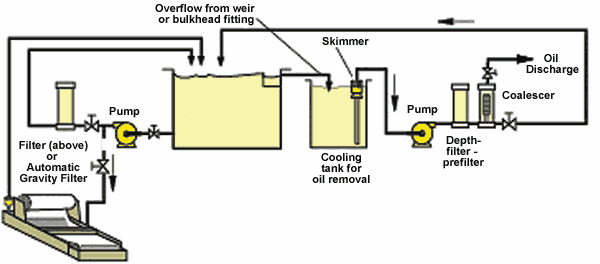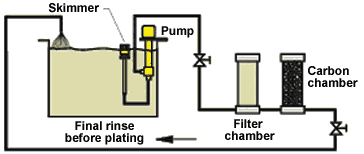Filter BEFORE the Plating Tank
How to reduce hazardous waste, while extending life of pretreatment solutions, to improve the quality of metal deposition.
Conventional wisdom says that you filter a plating solution to keep contaminants from being included in the plated deposit. The simple fact is that you can’t afford not to filter plating solutions. But that doesn’t mean that you should not look for ways to lessen the labor cost to service the filter, and to lower the costs of disposal of the media and replenishing solution loss.
While there may be no way to eliminate plating-solution filters without causing problems, filtration of solutions that prepare parts for plating can prevent problems before they develop in the plating solution itself, and make the plating filters last longer. Because the filter media used in the plating tank has to remove the particulate and organic contamination from the plating solution, regardless of source, it’s better to minimize or eliminate the amount of contamination being dragged down the cleaning line and into the plating solution.
Attention to prevention can eliminate 80-90% of such contamination. The final rinse before plating is a good place to remove particulates and organics, which due to surface tension, have traveled from the cleaner to the acid or etch tanks and are poised to enter the plating tank.
With the proper use of filters, coalescers and activated carbon on solutions from the soak cleaner to the plating tank, you can expect to prevent up to 90% of solids and organic contaminants from entering the plating solution. Use a separate filter chamber containing granular carbon to recirculate the acid and pre-rinse.
This leaves the organic breakdown products from the plating-solution brighteners as the only other contaminant that requires the use of carbon on filters for the plating solution. Carbon filtration is necessary to remove these breakdown products, but the amount of organic contaminants can be greatly reduced by switching from air agitation to eductor agitation. This creates the necessary movement of the ions for faster plating, while reducing the breakdown of the brightener system.
It is also important to note that carbon should not be used as a filter aid. Filters remove insoluble solids, while carbon adsorbs organics from the solution. The powdered carbon, which is coated onto a filter media surface, is not a filter aid.
The use of 1 ½ oz/sq ft of filter aid plus up to 3 oz/sq ft of powdered carbon on disc filters for continuous filtration and organic contamination removal is not recommended. That’s up to 4.5 oz/sq ft of filter media to remove the solids or organics present in the plating tank, or 300 to 450 oz/100 sq ft of a surface-type filter. It means that more than 28 pounds of hazardous material must be properly disposed of every time the filter is serviced (once or twice a week on many plating baths). And you pay for the solution lost during servicing.
Diatomaceous earth (DE) is the filter aid of choice, and any powder, such as carbon or DE, is a solid that lowers the solids-holding capacity of the filter. The result is more frequent servicing, not only because the flow rate has been lowered, but also because the carbon blinds off, preventing it from adsorbing organic impurities.
Taking steps such as filtering the stages of plating pretreatment prolongs life of the plating filter, making it possible for this filter to last up to ten times longer between servicing.
Another plus: Faster Plating! One recent report indicated that a plater using such techniques could plate up to 33% faster at higher amps, without burning. It made it possible for this company to bring in more parts from its customer without the need to purchase another automatic plating line.
A further benefit of controlling the amount of solids in the plating tank and the level of organic impurities in the drag-out solution is that drag-out now can be added back into the plating tank without building up high levels of contamination. This reduces the load on pollution-control facilities.
Contaminant-Free Plating Solutions
In today’s world of precision plating, there are parts that require contaminant-free plating solutions. They just can’t tolerate the slightest roughness or discontinuity. In some cases platers have purchased instruments that monitor clarity and thus indicate when it’s safe to place the part on the cathode rod. The problem with this is that the instruments do not assure the plater that during the time of deposition, the solution stays free of contamination that could be introduced from the air, the anodes or migrating filter media.
The money spent on the instrument should have been used to upgrade the filtration system, including filters for pretreatment solutions, to assure that the solution would stay free of contamination.
In precision plating it may be necessary to eliminate all particles larger than a specified size. To meet these needs you should recognize the difference between nominal and absolute filter media. Nominal filter media ratings assure the removal of 85-95% of the particles that are no larger than the media rating. Absolute filter rating assures that 100% of the particles larger than the rated size will be removed.
Neither type of filter media assures that lower-size particles will not be present in the plating solution, or that particles being generated during plating cannot be deposited. But when the proper media and flow rate (turnover) are combined, a predictable degree of clarity can be accomplished. The plating of memory discs for computer hard drives, for example, requires 40–50 turnovers per hour with media providing 0.1-μm absolute particle retention.
For normal high-production plating there are cartridges that can filter oily alkaline solutions. They have coarse windings that extend time between filter servicing. (Platers of alkaline zinc used them when they converted from cyanide zinc because their cleaning was inadequate and the coarse filter media held more solids, going sometimes 6–8 weeks between servicing.) Other solutions such as acid zinc or bright nickel often use 5- to 15-μm cartridges, but certain nickel applications may require a 50-μm filter cartridge at high turnover rates to provide best results.
No Need for Plating Filtration?
Did we completely eliminate the filter on the plating solution? Absolutely not. But with pretreatment-solution prevention in place we have significantly reduced the servicing of the plating-filtration system, not to mention improving quality and reducing rejects.
You now have a system of filtration and separate pretreatment purification in place that will pay many dividends from less solution contamination, fewer solids for hazardous waste disposal, less labor for servicing and, as we’ve said before, “unattended filtration” and purification, from day-to-day and month-to-month.
Talk to your chemical supplier. He knows the value of getting rid of solids and organic contamination as it applies to reduced service requirements.
Talk to your customer. He knows the value of more uniform deposits with improved corrosion prevention and ductility.
Talk to your production staff. They know the value of fewer rejects.
Serfilco, Ltd., Service Filtration Corp.
Related Content
A Chromium Plating Overview
An overview of decorative and hard chromium electroplating processes.
Read MoreProducts Finishing Reveals 2023 Qualifying Top Shops
Each year PF conducts its Top Shops Benchmarking Survey, offering shops a tool to better understand their overall performance in the industry. The program also recognizes shops that meet a set of criteria to qualify as Top Shops.
Read MoreTroubleshooting Alkaline Zinc
One of the most common problems that can arise when plating with alkaline zinc is an imbalance of brightener in the solution. In this helpful Ask the Expert article, Chad Murphy of Columbia Chemical discusses how different zinc metal concentrations and brightener concentrations can impact efficiency.
Read MoreTrivalent Chrome Overview
As the finishing industry begins to move away from the use of hexavalent chromium to trivalent chromium, what factors should finishers consider as they make new investments? Mark Schario, chief technology officer for Columbia Chemical offers a helpful overview of this complicated topic.
Read MoreRead Next
Episode 45: An Interview with Chandler Mancuso, MacDermid Envio Solutions
Chandler Mancuso, technical director with MacDermid Envio discusses updating your wastewater treatment system and implementing materials recycling solutions to increase efficiencies, control costs and reduce environmental impact.
Read MoreEducation Bringing Cleaning to Machining
Debuting new speakers and cleaning technology content during this half-day workshop co-located with IMTS 2024.
Read MoreDelivering Increased Benefits to Greenhouse Films
Baystar's Borstar technology is helping customers deliver better, more reliable production methods to greenhouse agriculture.
Read More
























